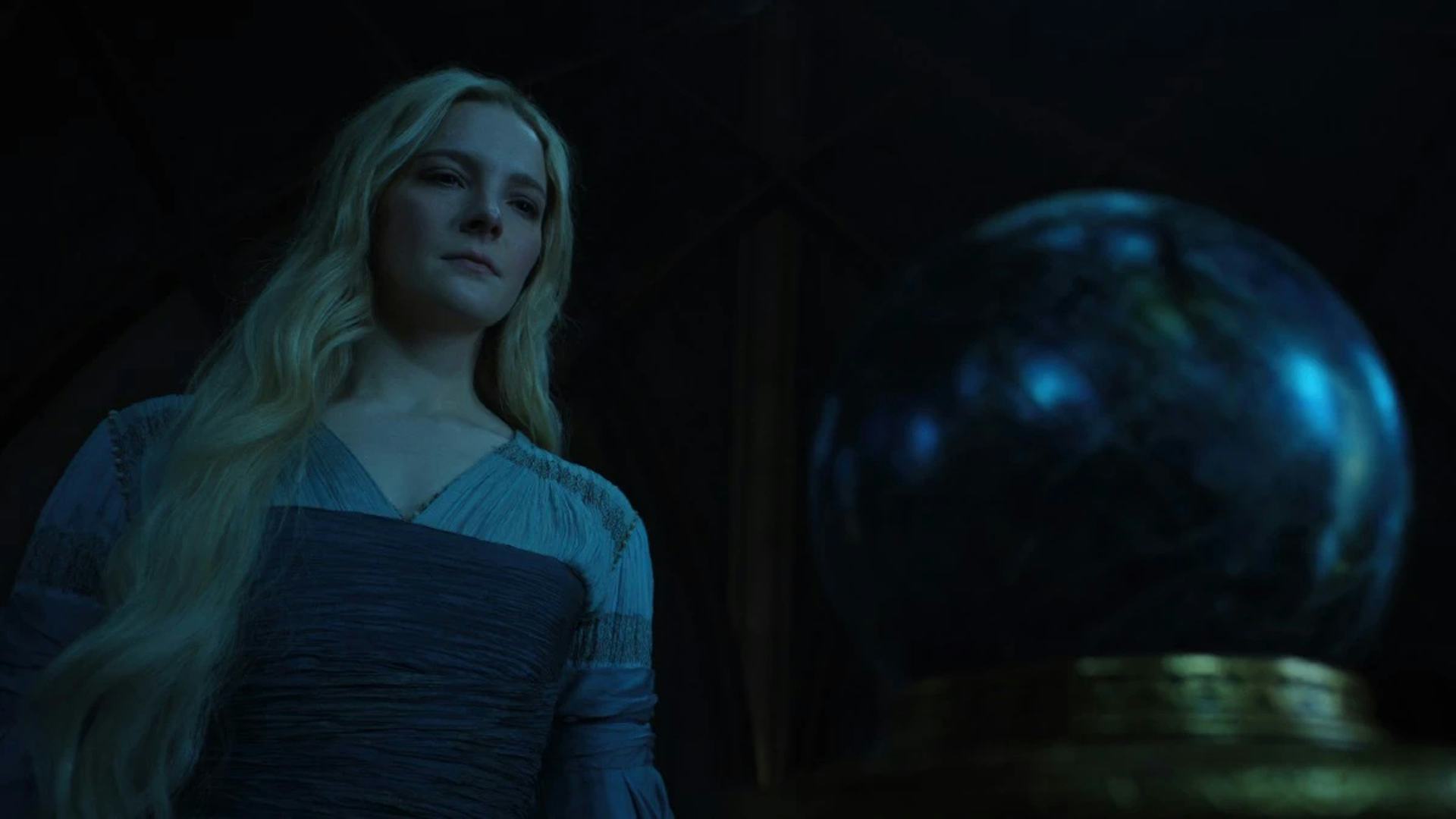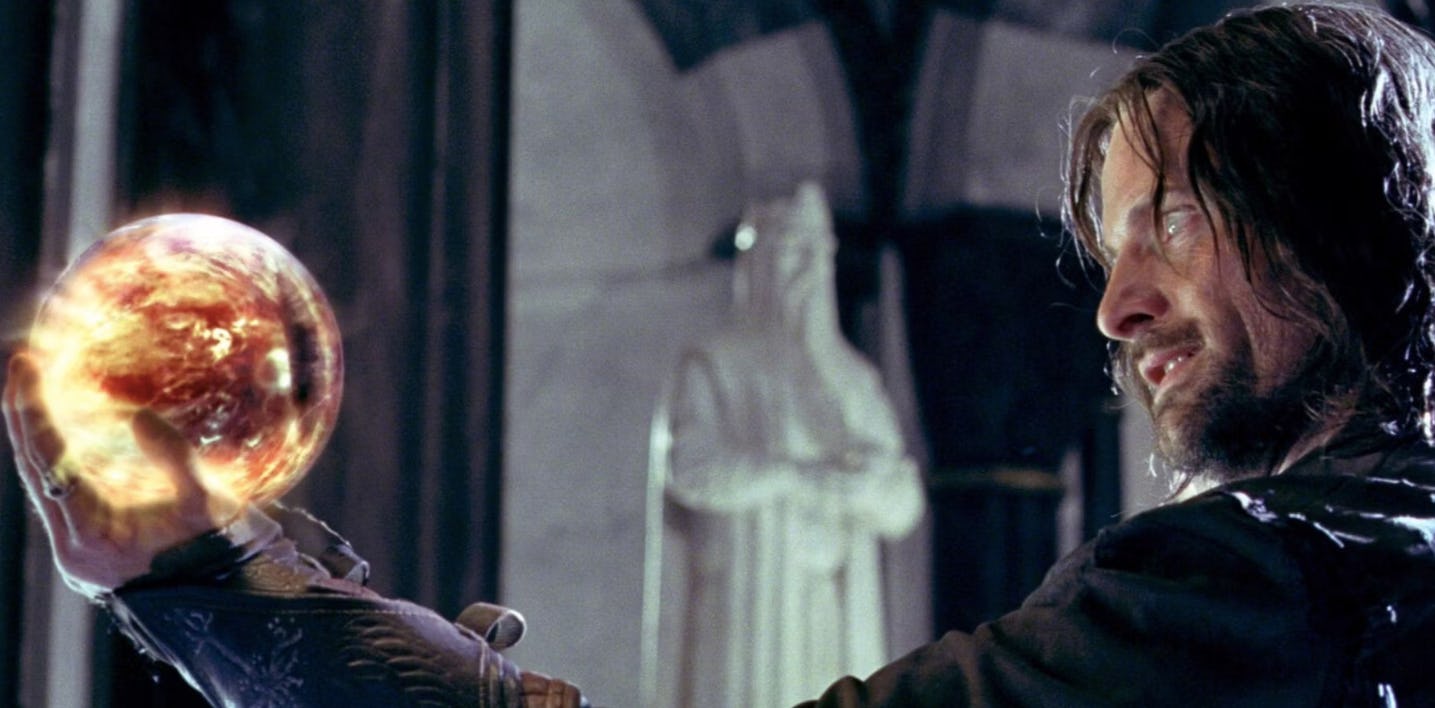
“I know what it is to be the only one who sees, the only one who knows,” Galadriel (Morfydd Clark) tells Queen Regent Míriel (Cynthia Addai-Robinson), attempting to soothe her and gain her confidence after both women witness a disturbing vision that threatens Númenor and the fate of humanity itself.
Spoilers ahead for The Rings of Power.
According to a Palantír prophecy depicted in Episode 4 of The Rings of Power — aptly titled “The Great Wave” — divine might will unleash a great wave and sink the island. The catastrophe is not a natural one either — it’s punishment. Is Galadriel’s presence in this kingdom of men to blame?
Here’s what we know about the Palantíri based on J.R.R. Tolkien’s writings and Peter Jackson’s films. Should we treat the doomsday visions as foreshadowing an unavoidable calamity, or is it an omen giving Galadriel and Míriel a chance to fix the future? And how does this redefine our understanding of the Palantíri as depicted in Peter Jackson’s Lord of the Rings movies? Let’s dive in.
What are the Palantíri and how did Númenor get one?

Palantíri (or Palantír if you’re referring to just one) are indestructible crystal orbs that allowed one to look across large distances, communicate remotely between two linked orbs, and even see images of the past, present, and future.
Although the Palantíri are bound to each other, they cannot transmit sound, further complicating how their messages are received and interpreted. The orbs also peak in performance when wielded by those the magical objects deem worthy of their power, but falter and give mixed signals when in the hands of lesser individuals.
The elves (possibly Fëanor) made the Palantíri during the First Age and then gifted them to faithful Númenóreans, which is how they arrived in the island kingdom depicted in The Rings of Power. When Númenor fell, Elendil and his sons took seven of them and placed them in protected towers across Middle-earth. However, after Sauron got his hands on one of them, it was no longer safe to use the Palantíri.

In Episode 4 of The Rings of Power, Queen Regent Míriel explains to Galadriel that her father kept repeating, “We must repent and return to the old ways,” growing adamant that the Númenóreans needed to retain fealty to the elves and the angelic Valar. Míriel soon came to understand her father’s paranoia. He too had seen the deluge that would destroy the island and its inhabitants when he engaged with the Palantír.
Galadriel, hearing Míriel’s explanation, agrees. Míriel, meanwhile, is unconvinced until the end of Episode 4, when the White Tree of Númenor suddenly starts losing its petals, that the Queen Regent swears to help Galadriel in the fight against Morgoth, the Dark Lord Adar, and the re-emergence of Sauron.
For now, we have one crucial question: is the prophecy of the great wave one that both Míriel and Galadriel should believe? How the Palantíri have been described in this latest episode of Rings of Power and in Tolkien canon gives us some clarity about what to expect in upcoming episodes — and vice versa.
How do the Palantíri in Rings of Power change Lord of the Rings?

Based on what occurs in Lord of the Rings, we know that when one of these orbs winds up with an enemy (like Sauron and Saruman), the magical spheres could be modified into selectively showing truthful images to manipulate weaker Palantíri users.
However, the Palantíri could also be unreliable if the “wrong” person sought to use them. In Tolkien’s The Silmarillion, only those who “possess great strength of will and of mind” could wield them to their full potential. Other people wouldn’t get the “full picture” of certain visions, often leading to misinterpretation and poor decision-making based on speculation. Even Sauron wound up deceiving himself with a Palantíri after Pippin touches a sister stone in Return of the King, believing that the hobbit had the One Ring.

It could be that the Palantír depicting a cataclysmic wave washing away Númenor is being distorted by another Palantír user. However, The Silmarillion and other Tolkien-penned appendices and posthumous texts do note that (spoiler alert) the island kingdom of Númenor doesn’t just fall, it drowns.
Considered another way, it’s worth noting that we’ve never seen a Palantír behave quite like this — at least not in the Lord of the Rings movies. Because Sauron had already corrupted the orbs by then, they couldn’t do much beyond spread his evil (and give away the user's location). But by revealing the original power of the Palantíri, Rings of Power helps explain why these items are so important — and why so many characters seem drawn to them throughout Middle-earth history.
Rings of Power airs Fridays at midnight on Amazon Prime.







